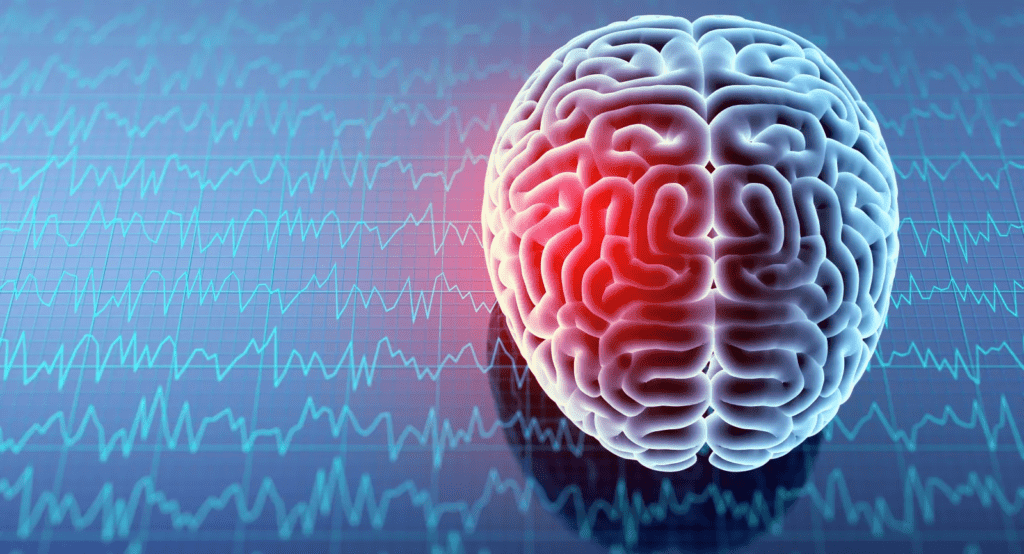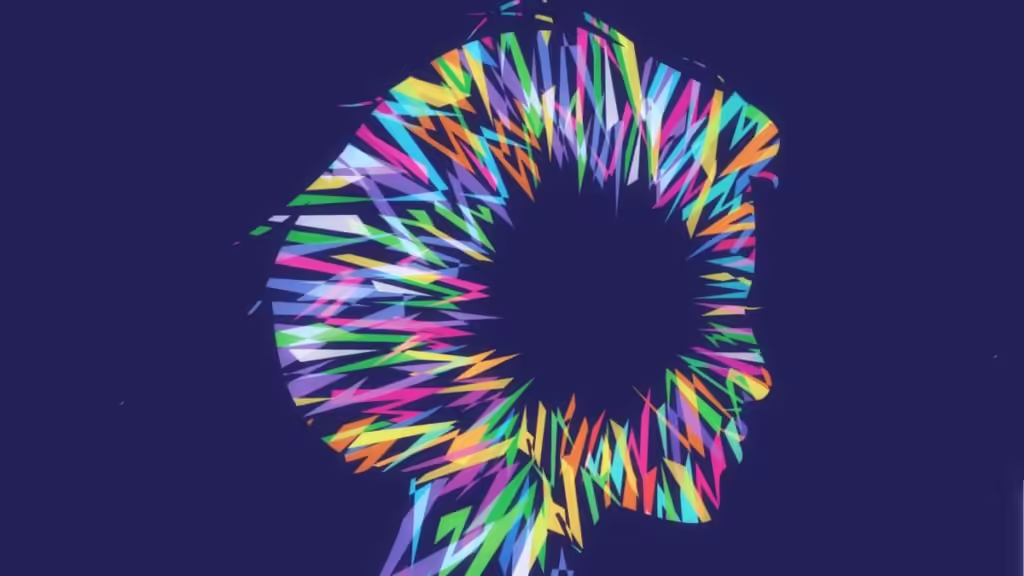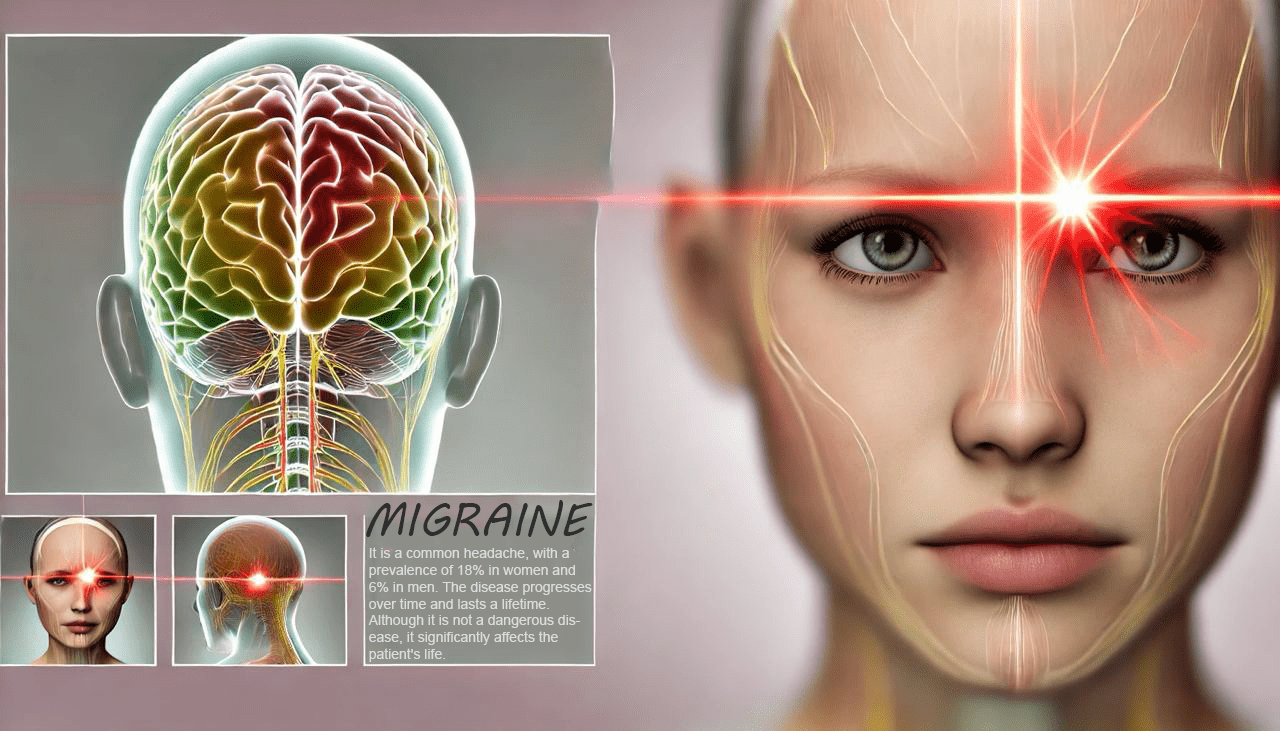Definition of migraine
Migraine is a type of migraine that occurs in pulsating, variable intensity and is cyclical.
It is a common headache, with a prevalence of 18% in women and 6% in men. The disease progresses over time and lasts a lifetime. Although it is not a dangerous disease, it significantly affects the patient’s life.
Causes of migraine
Migrainous headache belongs to the group of primary headaches, meaning there is only a headache without any other accompanying pathology.

The pathophysiology of migraine is still unclear; three mechanisms occur in the following anatomical regions:
- The phenomenon of vasoconstriction and dilation of blood vessels in and outside the brain.
- Activation of serotonin-secreting neurons in the brainstem.
- Activation of the trigemino-vascular nervous system causes the release of vasoactive substances and pain.
Symptoms of migraine
Migrainous headache usually starts on one side; however, it can spread to both sides. Additionally, the pain often pulsates, and the patient may feel the temporal artery pulsing. As the intensity gradually increases, it becomes severe. Moreover, the duration of the attack ranges from 4 to 72 hours.
In addition to the pain, symptoms that commonly accompany the headache include fear of light, fear of noise, nausea, and vomiting. Consequently, the patient often seeks a quiet and dark place to rest and alleviate the discomfort.
Furthermore, migraines can be categorized into two main types:
- Migraine with aura, also known as classic migraine:
- Patients often have a transient aura phase about 30 minutes before the pain.
- Symptoms are mainly in the eyes.
- Bright spots appear in the patient’s visual field, moving in a zigzag shape.
- Patients may temporarily lose half of their vision on the same side as the pain.
- Less common symptoms are facial numbness, hand numbness on the same side, and transient language loss.
- When these aura symptoms disappear, the headache appears typical.

- Migraine without aura is also called common migraine:
- The patient has typical headaches but no aura.
- The intensity of the pain is usually less than that of migraine with aura.
- Accompanying symptoms may appear, such as loss of appetite, fatigue, and depression.
Chẩn đoán
Diagnostic criteria for migraine with aura according to the World Headache Society:
Headaches with typical characteristics as above and accompanied by at least three of the following four characteristics:
- Some auras appear and disappear entirely, indicating a local disorder in the brain.
- One or more auras that appear gradually over four minutes or two auras that appear consecutively.
- No auras that last more than 60 minutes.
- Headaches that appear after a maximum of 60 minutes of auras.
Diagnosis criteria for migraine without aura according to the World Headache Society:
- There are at least five attacks with the following characteristics: pain lasting 4-72 hours with at least two symptoms: pain on one side of the head, pulsating pain, moderate or severe intensity, and pain that increases with exertion.
- During the attack, there is at least one of the four accompanying symptoms: nausea, vomiting, photophobia, and phonophobia.
Chẩn đoán phân biệt:
Differential diagnosis of migraine with other diseases is necessary to provide effective treatment and prevention strategies:
- Tension headache
- Cluster headache
- Secondary headache due to brain diseases such as brain tumors, meningitis, stroke, trauma, and psychological disorders.
Điều trị
Migrainous headache treatment requires a combination of methods to bring the best results for the patient:
- Treatment to stop the pain is necessary in all cases because the patient is very uncomfortable due to moderate to severe pain.
- When there are more than three attacks per month, a preventive approach is needed to manage them.
- The effectiveness of treatment to prevent attacks depends on how well the treatment to stop the attacks works. For example, if pain attacks occur frequently but are easily managed, then focusing solely on stopping the attacks may be sufficient.
- Avoid triggering factors.
- Combine psychological counseling therapies.
- Non-drug treatments are gradually proven effective: music therapy, aromatherapy, acupressure, and acupuncture.
Điều trị dùng thuốc
- Common pain relievers: Paracetamol/Ibuprofen/Aspirin
- Triptan groups of drugs need to be used with caution by doctors.
- Anti-emetics: These are more effective early in the attack, usually metoclopramide or Domperidone.
- Preventive treatment: use approved evidence-based drugs such as beta-blockers, anti-epileptic drugs, Flunarizine, and Amitriptyline.
Status Migraine
It is a condition of severe, resistant migraine attacks accompanied by severe vomiting. Status Migraine is often the result of overuse of migraine medications. These cases require treatment and monitoring in the hospital.

Phòng ngừa
Migraine is not a dangerous disease, but to manage and avoid recurrence is a real challenge. We need to pay attention to some factors as follows:
- Avoid foods and drinks containing stimulants such as tea, coffee, alcohol, and beer.
- Keep yourself relaxed and avoid psychological stress.
- Live, eat, and rest regularly.
- Avoid abusing drugs, especially painkillers.
- Exercise moderately to increase the body’s flexibility in the face of life’s pressures.

